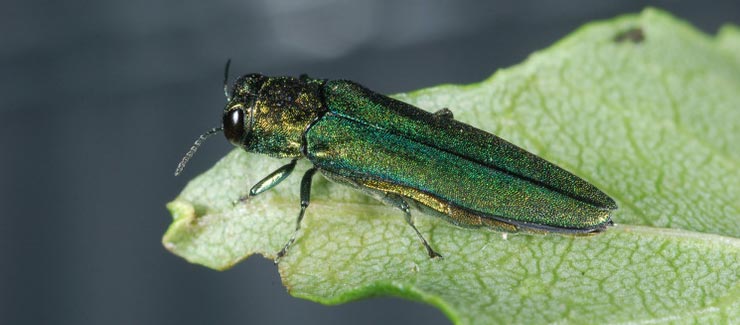When the state announced late last month that it had added several communities in southern Oxford County to its emerald ash borer quarantine, I feared we were losing the battle to the deadly pest.
As it turned out, the news wasn’t quite that bad, and while the state may lose the battle, the fight is still worth the effort.
“We are really only slowing the spread of the emerald ash borer,” State Entomologist Allison Kanoti said in a telephone interview. “We are buying time for people who rely on ash for their manufacturing.” She mentioned Eddington toolmaker Peavey Manufacturing and the flooring industry as two examples.
Maine has two areas infested or imminently threatened by the emerald ash borer, a bright green beetle from Asia that first showed up in the United States in Michigan in 2002. One is in northeastern Aroostook County, and the other encompasses York and Cumberland counties as well as southern Oxford County.
The spread in southern Maine appears to be natural, not the result of people inadvertently transporting the beetle to new areas on untreated firewood. Improperly moving firewood can spread the pest hundreds of miles at a time, as it hitches a ride on the wood. Kanoti said the expansion in southern Maine is likely just the continuing natural progression of the pest, a progression that moved across the United States and Canada from Michigan. The beetles can fly about a half a mile from the tree where they emerge – the females lay their eggs in trees – so that’s roughly the extent of natural spread annually.
In Aroostook County, the quarantine was announced after the beetle showed up in an isolated spot in Edmundston, New Brunswick, right across the U.S. border from Madawaska. How it got there is still a mystery, but it wasn’t natural spread because there is no outbreak within half a mile.
Given the possibility that the emerald ash borer eventually arrives in all of Maine, I wondered if the state’s forest will be denuded of ash trees. Fortunately, the answer is no. While ash trees grow all over Maine, the highest percentage is in an area that runs roughly from Fryeburg to Houlton, and especially just north of Augusta and Bangor. So, the range of the worst devastation will be somewhat limited.
In addition, the emerald ash borer leaves some ash trees behind, Kanoti said, although how many will grow long enough to become mature, 80-foot trees is an open question. In Michigan, she said, white ash has a survival rate of up to 75 percent after the beetle hits, but that rate is much lower – sometimes near zero percent – for green and black ash. Unfortunately, the black ash (sometimes, confusingly, called brown ash) is the variety that Wabanaki tribes depend upon for basketmaking and other activities. Dove Tail Bats in Shirley Mills, whose baseball bats are used by many Major League players, uses white ash (in addition to rock maple and yellow birch) in its products.
By the way, despite its common name, mountain ash, or Sorbus americana, is not actually an ash. It is part of the rose family. The tree is native to Maine, produces fruit and flowers, and benefits wildlife. And – nice to have some good news – the emerald ash borer does not threaten it. Ash trees, by contrast, go by the botanical name Fraxinus, and are related to lilacs and olive trees (which, interestingly, the emerald ash borer does not damage, Kanoti said).
Another reason for hope, Kanoti said, is that the state has released three types of biological controls in an attempt to curb the beetle. They are all wasps – tiny ones, so don’t worry about being stung – that attack the eggs or larvae of the borer. The releases have been done in Cumberland and York counties and at the Aroostook County site, in cooperation with the federal government.
“The jury is still out on those,” Kanoti said.
I was excited by the release of biological controls. A few years ago, my hometown of Cape Elizabeth had a huge invasion of winter moth, which denuded trees – oaks were hit hardest, but other trees were damaged as well. Releases of parasitoid flies seem to have had an impact in slowing the harmful moth. But Kanoti dashed my expectations. Other releases against winter moths have been less successful than that in Cape Elizabeth, she said, adding that these biological controls are still being tried.
I do hope the controls work eventually, on both emerald ash borer and winter moth. The Wabanakis, the state’s tool makers and all nature lovers would like to keep these devastating pests at bay.
Tom Atwell is a freelance writer gardening in Cape Elizabeth. He can be contacted at: tomatwell@me.com.
Send questions/comments to the editors.



Success. Please wait for the page to reload. If the page does not reload within 5 seconds, please refresh the page.
Enter your email and password to access comments.
Hi, to comment on stories you must . This profile is in addition to your subscription and website login.
Already have a commenting profile? .
Invalid username/password.
Please check your email to confirm and complete your registration.
Only subscribers are eligible to post comments. Please subscribe or login first for digital access. Here’s why.
Use the form below to reset your password. When you've submitted your account email, we will send an email with a reset code.